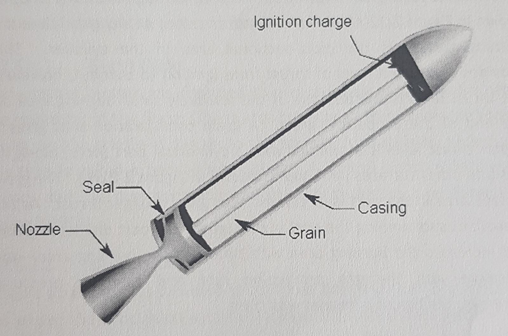Reading Activity
A rocket motor is the usual source of missile propulsion. Figure 11 illustrates a typical solid propellant rocket motor. The solid propellant grain contains a fuel and an oxidizer, which burn inside the ‘combustion chamber to create high-pressure, gaseous combustion products. The gas is exhausted through a converging-diverging nozzle at supersonic speed. If the incremental pressures acting on the inside and outside surfaces of the combustion chamber and nozzle are integrated (summed), the result is net force acting along the axis of the rocket motor. This force is called the thrust. A more convenient method of calculating and analyzing rocket motor thrust is based on the principle of conservation of momentum.

Fig. 11 Solid propellant rocket motor
A cylindrical solid grain with all surfaces inhibited except one end, as shown in Figure 12(A), bums at a uniform rate. At any given time the burning surface is the cross-sectional area of the cylinder. This provides a constant level of thrust from ignition to burnout; however, the thrust level is low because of the relatively small burning area on the end of the propellant grain. A grain configuration that gives a higher thrust level is a cylinder with a cylindrical port (hole) along its axis and other surfaces inhibited as shown in Figure 12(B). The grain surface area in the port is larger and thus gives a larger thrust.
A rocket motor whose thrust increases with time is said to have progressive burning characteristics. A more neutral burning characteristic is obtained when the cross-section of the port is shaped like a star, as illustrated in Figure 12(C).

Fig. 12 Propellant Grain Configurations